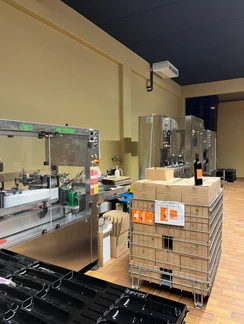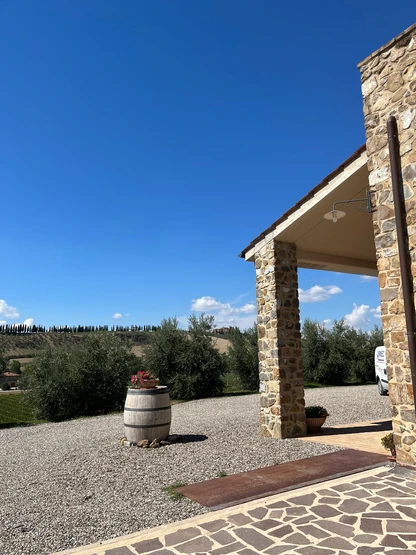
Gantry and The Tuscan Sun
https://www.antoniaswineadventures.com/post/under-the-tuscan-sun
After flaunting around the Tuscan countryside in September, having remarkable wine and some of the best food I’ve ever had, I have finally gotten around to sharing the tale.

In September I was whisked away with The Scottish Gantry to the beautiful Tuscan countryside to visit some of our wine suppliers and try some new wines which we hoped to buy in.
Arriving very late into Pisa (thanks to a delayed Ryanair fight), we drove down into the Tuscan countryside arriving in the wee sleepy hours to a very quiet San Gimignano. The beautiful cobble streets echoed with the distant crickets and soft hum of a sleepy town.
Waking up in the morning, we had the pleasure of opening the curtains to the rolling hills, towering Cyprus trees, scrawling vineyards and clear blue skies. Breakfast looked over the little terracotta town and as I sipped my café latte, I couldn’t have dreamed what the week had in store.
We were quickly whisked away in the sprinter van after meeting the marvellous Claudia and Alberto, our lovely consultants who introduced us to the best Tuscany has to offer.
Our first stop was in the charming town of Montalcino, at the top of the hill lay the historic Il Marroneto. The 9 hectare vineyard look over the Brunello valley. Owned by Alessandro Mori, this is one of the older Montalcino estates being founded in 1974. The estate refers to the deep religious underpinning of the past, Marraneto meaning ‘Old Tower’ was the Madonna delle Grazie convent, housing nuns in the 13th Century. The top wine produced ‘Madonna’ portrays this connection. The Madonna single vineyard plot being the one closest to the winery where the Nuns would have prayed.
Arriving at the vineyard, we entered from the back of the old countryside villa. This stone building was very deceiving as when we walked round the front we were greeted with the splendour of the Brunello valley. Walking under the Sangiovese vines and hanging grapes into the historic building was a lovely welcome.
Il Marroneto is 400 meters above sea level with complex soil types consisting mainly of sand, limestone and galestro. When studying my Diploma, picturing the different soil types and understanding their benefits was one of the aspects of the course I found most interesting. However, it was sometimes difficult to remember and I vowed I would make it easier for my students (and myself) by studying the soil each time I went to a new vineyard. I took samples from the Madonna plot in Montalcino, which were very different to the soils elsewhere in Tuscany.
The Brunello wines are typically elegant, refined and long lived. We were lucky enough to taste these right from the barrel. In typical Italian hospitality, we must have tasted around 15 samples from different plots, vintages and oak types. Each of these wines were different, my favourite being the Madonna 2019. After jumping about the cellars numbing our taste buds with more and more samples, we descended the stairs into history. The dark cellar was one of the best parts of the tour. We sat around the table hearing more about the history, listening to Claudia, Alberto and Mateo speak in rushes of Italian and enjoyed the true essence of the Tuscan wine adventures. I feel being in the trade and meeting winemakers to discuss business rather than being a tourist gave us a much deeper reality of the processes. The veil was lifted and we got to experience the true nature of the winery.



After a fantastic first vineyard, we jumped back in the van and descended into the valley, once more braving the country roads. Next stop, Sasso Sol!
This newer winery and vineyard had less of the rustic charm than Il Marroneto. In contrast, everything at the top of the hill is done with minimal intervention and old winemaking techniques. Sasso Sol has recently undergone a refurbishment, showcasing their huge 2000l oak barrels, bottling line and stainless-steel tanks for fermenting the wines. Where Il Marroneto is rustic its dark and dusty demeanour added to the richness of heritage and experience. Visiting Sasso Sol showed the difference winemaking techniques and vineyard location can have on the Sangiovese grape. I would describe the difference being Il Marroneto is the grandfather who has years of experience getting things right and Sasso Sol being the grandson who has taken a risk; which has paid off.
We got a tour of the winery and talked through each of the production processes. After this, I was thrilled to see the cellar had been set up for lunch. At this point I should have realised what I was in for. The next five days I was going to consume some of the best food I have ever eaten, this was the prelude of what was to come. We enjoyed six wine samples with local meats, cheese and what was to become a staple of any meal (and the whole trip) olive oil. On the trip I must have consumed a bottle of oil. We had it with every meal, including breakfast, bathed in olive oil soap and lathered on olive oil moisturiser every night.






At Sasso Sol I tried sparking Sangiovese for the first time. Pale pink in colour, this wine had a vigorous moouse (very bubbly) and beautiful soft red berry and herbal notes. It was delicious and very refreshing on a sunny day. We worked our way through the samples tasting the younger, fruitier Orcia Sangiovese and Rosso di Montalcino before diving into the richer Brunello di Montalcino and Bunello di Montalcino Riserva. It was interesting to see the difference between wines in Sasso Sol and ll Marroneto.



After a long leisurely visit, we returned to our base in San Gimignano where we had some time to look about the market stalls and try the world’s best ice cream (It was amazing, extremely creamy). We wandered around the cobbled streets and snuck up alleyways finding the local church before settling in a bar for a sundowner. We were invited to Claudia and Alberto’s for pre-dinner drinks on the balcony. As a thank you we stopped in a beautiful small deli and picked up a selection of antipasti bits including cheese, artichoke and some fennel wild boar, which soon became a favourite of mine!
Dinner was at Ristorante Peruca, tucked up a side street this restaurant felt like we were stepping back in time diving into an old wine cellar. We enjoyed a half bottle of Vernaccia, the indigenous grape of San Gimigano and again were amazed by the quality of the food. I had an onion tarte with Pecorino ice-cream (I still dream about this daily) to start followed by pear tortellini. Unusual but unreal! Well-watered and fed, we wandered back through the town for an early bed after a wonderful first day.


























